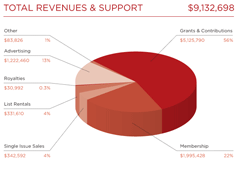Nonprofits and news

Revenue structure for nonprofit magazine
Mother Jones.
© 2009
Mother Jones
The term “nonprofit” described a corporation that was not organized for the financial enrichment of private owners or shareholders. [1] Such enterprises were commonly called 501(c)(3)s, after the section of US tax law that governed them. They were exempt from federal income tax. In addition, donations to such organizations were generally tax deductible—that is, a donor could subtract some of the amount of the donation from his or her taxable income. Any excess revenue a nonprofit had after meeting its expenses had to be reinvested back in the company. The most common types of 501(c)(3)s were hospitals, churches, and schools. Prominent US nonprofits included nationwide organizations such as the Girl Scouts and the Salvation Army.

Expense structure for nonprofit magazine
Mother Jones.
© 2009
Mother Jones
News organizations were not specifically listed as eligible for tax-exempt status under section 501(c)(3). But nonprofit news had several precedents, most notably in broadcast. Both National Public Radio (NPR) and the Public Broadcasting Service (PBS) were nonprofits that relied on a mix of corporate sponsorship, foundation support, member donations, and government funding to provide public affairs programming nationwide. [2] But NPR and PBS were unique entities, created under a 1967 US law that committed the federal government to provide some of their funding. [3]
In addition, there were a number of nonprofit news organizations which had no government support. Magazines like Harper ’s and Mother Jones , and the Florida newspaper the St. Petersburg Times , relied for much of their budget on donations and endowments created by their wealthy founders. Each also brought in some advertising and subscription revenue. [4]
In theory, these varied sources of support gave a news organization financial stability. For-profit news organizations typically earned roughly 80 to 90 percent of their revenue from advertising, which was highly dependent on the business cycle. Donations, particularly foundation grants disbursed over several years, were less volatile—though donations, too, tended to slow down in recessions and pick up in expansions.
Yet nonprofits had their own problems. They devoted a great deal of time to seeking and preserving sources of funding. Some were more successful than others at maintaining editorial independence from their funders. [5] Donors frequently tied support to a specific area of coverage—a hospital might fund a health-reporting position, for example. In contrast, advertisers by tradition were assiduously “walled off” from editorial content.
Another challenge was attracting a diverse funding base. Section 501(c)(3) distinguished between “private foundations” and “public charities.” A news organization fell into the latter category. Public charity status could mean thousands of dollars in tax breaks annually. But to qualify, a corporation had to demonstrate within a stipulated period that it was either a church, school, hospital, or governmental unit, or that it received a broad base of financial support from the general public. The IRS sent Voice a letter setting December 31, 2008 as the end of its trial period. That meant Woolley could act as its primary financer for no more than four years; thereafter, Voice would have to seek other sources of support.
[1]
Exemption Requirements,
United States Internal Revenue Code, Section 501(c)(3).
[2] Leonard Downie, Jr. and Michael Schudson, “The Reconstruction of American Journalism,” Columbia Graduate School of Journalism, October 20, 2009.
[3] The federal government provided roughly $400 million a year to public broadcasting through the private, non-profit Corporation for Public Broadcasting. Downie and Schudson, "The Reconstruction of American Journalism," p. 78.
[5]
Jack Shafer,
“Nonprofit Journalism Comes at a Cost,”
Slate
, September 30, 2009.